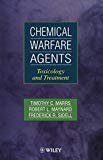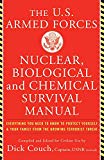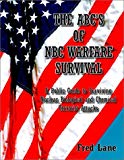Types of Chemical Weapons
Nerve Agents
Nerve agents attack the bodies nervous system. Nerve agents causse breathing difficulties, convulsions, paralysis, and death. Nerve agents can be inhaled or absorbed through the skin. Symptoms of nerve agent poisoning include runny nose, tightness of chest, difficulty breathing, excessive sweating, nausea, vomiting dimness of vision, pinpointing of the pupils, convulsion, and death.
Blister Agents
Blister agents attack the lungs, eyes, and skin. They blister both skin and mucous membranes.
Blood Agents
Blood agents interfere with the bodies ability to absorb oxygen. The victim dies because the body tissues are starved of oxygen. Blood agents cause headaches, vertigo, and nausea before death.
Choking Agents
Choking agents attack the lungs, causing them to fill with fluid. Choking agents are detected by their smell and their irritancy. The victim suffocates by drowning in his own body fluid. Choking agents cause coughing, choking, tightness of the chest, nasea, headache, and watering of the eyes.
Common Chemical Weapons
| Name | Odor | Rate of Action | Injuries | Protection |
|---|---|---|---|---|
| Phosgene (CG) | Freshly mowed hay, green corn | Immediate to 3hrs | Damages and floods the lungs | Gas mask |
| Diphosgene (DP) | Freshly mowed hay, green corn | Immediate to 3hrs | Damages and floods the lungs | Gas mask |
| Sarin (GB) | Almost none | Immediate | Difficulty breathing, death | Gas mask and protective clothing |
| Soman (GD) | Fruity, camphor odor | Immediate | Difficulty breathing, death | Gas mask and protective clothing |
| VX | None | Immediate | Death | Gas mask and protective clothing |
| Hydrogen Cyanide (AC) | Bitter almonds | Immediate | Blocks absorption of oxygen | Gas mask and protective clothing |
| Cyanogen Chloride (CK) | Bitter almonds | Choking and breathing difficulty | Gas mask | |
| Mustard Gas - Distilled (MD) | Garlic | Hours to days | Blisters, injures blood vessels, destroys tissues | Gas mask and protective clothing |
| Nitrogen Mustard (HN) | Fishy or musty | 12 hours or longer | Blisters, injures respiratory tract, destroys tissues | Gas mask and protective clothing |
| Phosgene Oxime (CX) | Sharp, penetrating | Immediate | Irritates mucous membrane of eyes and nose | Gas mask and protective clothing |
| Lewisite (L) | Geraniums | Immediate | Poisoning | Gas mask and protective clothing |
| Mustard Gas / Lewisite Mix (HL) | Garlic | Immediate pain and blistering for twelve hours | Blisters, injures blood vessels, destroys tissues, poisons | Gas mask and protective clothing |
| CS | Pepper | Immediate | Irritation | Gas mask and protective clothing |
Note: This chart is to be utilized as a rough guideline. Odor, Rate of Action, and Injuries can very based upon concentration and chemical purity.
Chemical Warfare Defense
Prevention and Treatment of Injury from Chemical Warfare Agents
The recent terrorist attacks on the US have led to many questions about the clinical effects, prevention and treatment of injury caused by chemical warfare agents.
An Alternative Health Care Facility: Concept of Operations for the Off-Site Triage, Treatment, and Transportation Center: Mass Casualty Care Strategy for a Chemical Terrorism Incident
The Concept of Operations for the Off-Site Triage, Treatment, and Transportation Center was written to assist planners, administrators, responders, medical professionals, public health, and emergency management personnel better prepare for and provide mass casualty care. This document presents the philosophy of care for the OST3C as well as operational planning considerations. The OST3C Concept of Operations is meant to be flexible and modular. The intention of this document is to provide jurisdictions with a basic understanding of the OST3C so that they can customize the concept to fit their specific needs and incorporate their version of the Center into the larger response effort.
Reference for Rapid Assessment and Treatment Of Chemical/Biological Agents
Quick reference list for treating casualties of chemical or biological warfare.
Health aspects of biological and chemical weapons
World Health Organization analysis of the health aspects of the possible hostile use of biological or chemical agents.
The Public Health Response to Biological and Chemical Terrorism
Interim Planning Guidance for State Public Health Officials
Chemical Warfare Protection
Information on how you can protect yourself against chemical warfare
The ABC’s of NBC Warfare Survival
A Public Guide to Surviving Nuclear, Biological and Chemical Terrorist Attacks
Emergency Response to Chemical/Biological Terrorist Incidents
In March of 1996, Fire Chief Lamont Ewell, who was then the president of the International Association of Fire Chiefs (IAFC), told the U.S. Senate Permanent Subcommittee on Investigations that it would be the responsibility of local firefighting, police and emergency medical units to cope with a terrorist attack that used nuclear, chemical or biological weapons. He also made the startling announcement that Fire/Police/EMS services, collectively, were not prepared for the challenge Ewell affirmed something that the Emergency Response and Research Institute (ERRI) in Chicago has been saying for a number of years 2. The chief told the packed Senate hearing room, “It will be local fire and emergency service organizations…who will have to pick up the pieces. Of the overall government efforts to prevent and respond to terrorist incidents, these local fire, law enforcement and emergency medical services agencies are the least prepared to respond to a chemical or biological terrorist incident.” International emergency analysts say that the same thing can be said for emergency service agencies all over the world.
CDC Emergency Topic: Ricin
CDC Emergency Topic: Sarin
Textbook of Military Medicine: Medical Aspects of Chemical and Biological Warfare
Chemical Decontamination
Chemical decontamination has 2 primary goals. Firstly, decontamination helps prevent further harm to the patient from the chemical exposure. Methods of patient decontamination include chemical dilution and chemical inactivation. Secondly, decontamination helps protect healthcare providers and maintains the viability of the ED as a treatment center. Mismanagement may result in illness in healthcare providers and contamination of the ED; severe ED contamination may necessitate departmental closure, which is potentially catastrophic in a mass casualty incident.
Chemical Detection Equipment
Several different technologies are used today to detect chemical agents (CAs). CAs are defined as chemicals intended to kill or seriously injure human beings. CDE usually detects the most common CAs: nerve agents, blister agents, and arsenical vesicants. A large variety of equipment is available that is capable of identifying liquid droplets of CAs on surfaces and in vapors. Laboratory-based equipment can detect agents in water. The main challenges with these technologies are ensuring an appropriate sample for analysis and filtering out nonhazardous environmental chemicals that may be present. This article focuses on the technologies and devices that may be used by first responder teams in the field. Laboratory detection techniques are beyond the scope of this discussion.
Chemical Warfare Agents
Chemical warfare agents comprise a diverse group of hazardous substances. Major categories of chemical warfare agents include Nerve agents (eg, sarin, soman, cyclosarin, tabun, VX), Vesicating or blistering agents (eg, mustards, lewisite), Choking agents or lung toxicants (eg, chlorine, phosgene, diphosgene), Cyanides, Incapacitating agents (eg, anticholinergic compounds), Lacrimating or riot control agents (eg, pepper gas, cyanide, CS), and Vomiting agents (eg, adamsite).
Chemical Warfare Mass Casualty Management
Specific measures to handle an incident involving a chemical weapon of mass destruction (WMD) should be integrated into existing hospital emergency preparedness plans. Although some of these measures are common, the demands that may result from a chemical WMD crisis require expanding existing hospital emergency preparedness plans, including the protection of employees and the physical plant.
Evaluation of a Chemical Warfare Victim
Patient triage only should be carried out in the hospital setting by those wearing appropriate personal protective equipment. In the simplest form of triage, patients or casualties are separated into 3 groups. The first group consists of those for whom the degree of medical care required exceeds that which is available. In this setting, medical assets are insufficient relative to the presenting illness, or an experienced triage officer deems the patient’s injuries irreversible. The medical focus is on comfort care, and the casualty is triaged as expectant. A casualty’s classification may change as assets become available or when later reevaluation demonstrates that the casualty’s condition was not as serious as first anticipated.
Emergency Medicine - Warfare - Chemical, Biological, Radiological, Nuclear And Explosives Articles
MSDS: VX
Material Safety Data Sheet: VX
Poison Warfare Gases: Treatment
Biological & Chemical Warfare and Terrorism
Advances Topics on Medical Defense Against Biological and Chemical Agents from the U.S. Army Medical Research and Materiel Command, the Department of Veterans Affairs’ Employee Education System, and the Emergency Management Strategic Healthcare Group.
Chemical Warfare Technology
Analysis of Chemical Warfare Agents
General Overview, LC-MS Review, In-House LC-ESI-MS Methods and Open Literature Bibliography
Chemical Warfare: History and Chemistry
Compared to other “weapons of mass destruction”, chemical and biological warfare has seen very little use. The potential threat of chemical and biological warfare is terrifying. Chemical and biological warfare is silent, pervasive, and deadly. You may not be able to hide from it.
The War Gases: Chemistry and Analysis
Mario Sartori
Some aspects of the chemistry and toxic action of organic compounds containing phosphorus and fluorine
Bernard Charles Saunders
How Biological and Chemical Warfare Works
VX Gas
Its chemical formula is CH3CH20-P(O)(CH3)-SCH2CH2N(C3H7)2 and is normally in its liquid state despite its name. It has a low volatility; is odourless and is an excellent adhesive. A special form has been developed that is so adhesive that it is virtually impossible to remove from the surface that it is in contact with. This leads to strategic attacks on enemy bases or airfields so that the VX remains stuck to the area and has the potential to kill any one attempting to use the base or airfield.
Chemical Weapons: Nerve Agents
Most nerve agents belong to a group of chemicals called “organophosphates”. The first of these chemicals was made in 1854 and was originally developed to be used to control insects and save crops. The first nerve agent (called “Tabun” or “GA”) for military use was made in Germany in 1936. Another nerve agent, “sarin” or “GB,” was made in 1938 and “Soman” or “GD” was made in 1944. It appears that these nerve agents were not used by the Germans during World War II. However, it has been estimated that the Germans had stockpiles of tons of both Tabun and Sarin. The United States and Russia continued producing and stockpiling these nerve agents after the War. In the 1950’s another nerve agent, “VX”, was produced in England.
Toxicological Properties of Nerve Agents
The nerve agents (GA, GB, GD, and VX) are all potent inhibitors of esterase enzymes found in the body. The most important of these from a toxicological point of view is acetylcholinesterase. Normally, this enzyme degrades (hydrolyzes) acetylcholine found in the synapses between nerves; acetylcholine transmits signals between nerve cells.
Conventional analytical methods for chemical warfare agents
Analytical methods that are currently used for the detection and identification of chemical warfare agents are reviewed and classified by the number of dimensions of information they provide. Single-dimensional sensors target specific compounds or classes of compounds. Although they can be less expensive and more portable than multidimensional sensors, multidimensional sensors detect a broader threat spectrum with greater precision and accuracy. The recommendation for analytical field verification during inspections under the Chemical Weapons Convention (CWC) is to use simple two-dimensional analytical methods, such as gas chromatography (GC) or ion mobility spectrometry (IMS), for on-site screening of chemical weapons (CW) agents or to fully equip a modern, mobile analytical laboratory located in an airplane, which can be moved rapidly throughout the world to each inspection site and provide high-quality analytical data on-site.
Technical Aspects of Chemical Weapon Proliferation
Of the three categories of weapons of mass destruction, chemical weapons are the most likely to be used in warfare, and they remain a serious threat in regional conflicts despite the end of the Cold War. Although well-equipped troops can defend themselves against existing chemical agents with detectors, decontamination equipment, gas masks, and protective garments (albeit at a some cost in military effectiveness), chemical weapons can still have devastating effects when employed against defenseless civilians or poorly equipped (or unprepared) armies or guerrilla fighters. This fact was starkly demonstrated during the 1980s by Iraq’s use of chemical weapons against Iran and its own Kurdish population.
Chemical Agent Multi Media/Toxicity Standards Status Table
OSHA standards for chemical warfare agent toxicity. Covers H/HD/HT (Mustard), GA (Tabun), GB (Sarin), GD/GF, VX, and Lewisite.
U.S. Patent 3060165
U.S. Patent 3060165: Preparation of toxic ricin
U.S. Army Field Manuals on Chemical Warfare
FM 3-3
Chemical and Biological Contamination Avoidance
FM 3-7
Nuclear Biological Chemical Field Handbook
FM 3-11
Multiservice Tactics, Techniques, and Procedures for Nuclear, Biological, and Chemical Defense Operations
FM 3-11-3
Multiservice Tactics, Techniques, and Procedures for Chemical, Biological, Radiological, and Nuclear Contamination Avoidance
FM 3-11.4
Multiservice Tactics, Techniques, and Procedures for Nuclear, Biological, and Chemical (NBC) Protection
FM 3-11.21
Multiservice Tactics, Techniques, and Procedures for Nuclear, Biological, and Chemical Aspects of Consequence Management
FM 3-14
Nuclear, Biological, and Chemical (NBC) Vulnerability Analysis
FM 3-101
Chemical Staffs and Units
FM 4-02.7
Health Service Support in a Nuclear, Biological, and Chemical Environment
U.S. Military Departments involved with Chemical Warfare
Medical Research and Materiel Command
We deliver the best medical solutions, for today and tomorrow, to enhance, protect and treat the warfighter on point for the Nation.
Medical Research Institute of Chemical Defense
To develop medical countermeasures to chemical warfare agents and to train medical personnel in the medical management of chemical casualties.
US Army Chemical Materials Agency
Enhancing the safe storage and elimination of the nation’s aging chemical weapons
Joint Program Executive Office for Chemical and Biological Defense
The JPEO-CBD vision is to eliminate the biological warfare (BW) threat by protecting the warfighter and other users. The JPEO-CBD provides biological warfare protection by rapidly developing, acquiring, and fielding the most effective biological detection, and BD vaccines and medical diagnostic equipment within cost, schedule, performance and logistical parameters.
Chemical and Biological Defense Information Analysis Center
Bringing the CB Defense and Homeland Security Communities Together





